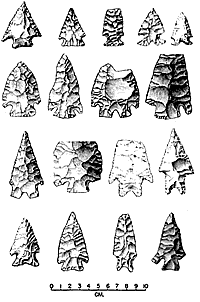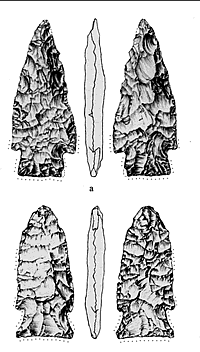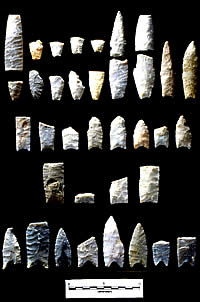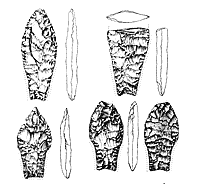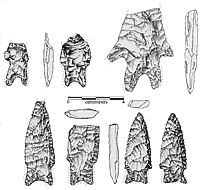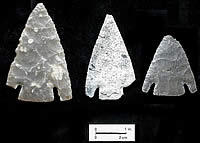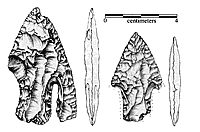Stemmed Dart Points
Throughout the 9,000-year span of the Archaic era, hunters used stemmed projectile points of varying styles, sizes, and forms to tip their weapons. The rather radical change in weaponry style from the more-streamlined lanceolate points used throughout most of the preceding Paleoindian era marks a distinctive technological shift.
The adoption (or perhaps invention) of the stemmed point form in Texas did not occur within a single time period, however, but rather in fits and starts, with a single stemmed point type—Wilson, or “Early Stemmed”—preceding others by some 2,500 years. Found at the Wilson-Leonard site in Williamson County in a circa 11,000-year-old cultural zone (as well as at other less securely dated sites across mainly central and south Texas), Wilson points were used by a people who buried their dead and practiced a broad-spectrum economy.
Unlike the more common lanceolate points still in use during that time period (and by earlier Clovis and Folsom cultures)—all of which were well-suited to thrusting lances or spears that could easily be withdrawn from animals—Wilson points were crafted with small barbs and a thick, heavily ground, expanding stem. While we cannot know all the reasons for this new entry among Paleoindian hunting kits, the Wilson point was among the first signals of more widespread changes to come as prehistoric Texans began to develop regionalized Archaic lifeways.
The use of stemmed dart points at this early time period may indicate experimentation and advances in weaponry systems, such as use of the atlatl as a dart-throwing device. (There is no direct evidence of this and some experts believe that lanceolate-tipped spears were also hurled with atlatls.) Prehistoric hunters, however, did not settle on the stemmed form to the exclusion of the earlier lanceolate type. At the Wilson-Leonard site, Wilson points were followed by additional Paleoindian lanceolate forms—the Plainview-like St. Mary’s Hall and Golondrina-Barber styles—as well as several Early Archaic lanceolate forms with contracting bases, such as Angostura and the unusually thick Thrall points. It was not until roughly 9,000 years ago that prehistoric hunters began making fully stemmed points, as seen in the Early Split-Stemmed series, such as Gower and Hoxie.
Changes in some projectile point forms may signal changes in hafting technology, as well. Whereas stemmed forms with primarily straight bases (such as Wilson) may have been fitted into split or slotted shafts, lanceolate forms with tapered bases (eg, Angostura, Thrall, and perhaps Hoxie) likely were wedged into a conical socket in the end of a foreshaft or shaft. The next wave of stemmed points forms had deeply concave or bifurcate bases (e.g., Early Split Stem), and these likely required a slotted shaft or foreshaft with a central protrusion on which the concave base could be securely seated. This latter hafting mode would have had decreased lateral movement, making them useful as knives as well as projectile tips. At Wilson-Leonard, a high degree of blade resharpening, including beveling, was seen in the Early Archaic points, supporting their likely heavy use as knives.
In other stemmed point forms, size and design may have been guided by a particular prey. Some have argued that the broad-bladed, deeply barbed Bell-Andice series as well as the Late Archaic Castroville and Montell styles may have been used for hunting bison, and indeed, the occurrence of these points in some areas may be correlated with more moist periods when buffalo were present. So far we do not have enough solid evidence to make the case.
What we can say with confidence is that dart point styles never remained constant for long. The hunters and warriors of the Plateaus and Canyonlands experimented with many different variations on the stemmed dart point theme. Although the general patterns through time are now fairly well known, much undocumented and unexplained variation exists. Some archeologists have argued that at any one point in time, one or two dart point styles held sway over much of the region, perhaps associated with specific cultural groups. Others of us strongly suspect that it was never that simple and believe that we are a long way from being able to sort out and explain the variations and themes of stemmed dart point style and technology through time.
